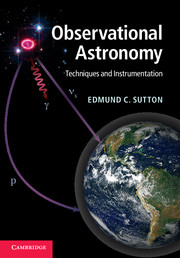Book contents
- Frontmatter
- Contents
- List of illustrations
- List of tables
- Preface
- Acknowledgements
- 1 Astrophysical information
- 2 Photometry
- 3 Positional astronomy
- 4 Fourier transforms
- 5 Detection systems
- 6 Orthodox statistics
- 7 Stochastic processes and noise
- 8 Optics
- 9 Interference
- 10 Spectroscopy
- 11 Ultraviolet, x-ray, and gamma ray astronomy
- 12 Radio receivers, spectrometers, and interferometers
- 13 Modern statistical methods
- 14 Neutrino detectors
- 15 Cosmic ray detectors
- 16 Gravitational waves
- 17 Polarimetry
- Appendix A Physical constants and units
- Appendix B Acronyms
- Appendix C Additional reading
- References
- Index
- Plates
15 - Cosmic ray detectors
Published online by Cambridge University Press: 05 June 2012
- Frontmatter
- Contents
- List of illustrations
- List of tables
- Preface
- Acknowledgements
- 1 Astrophysical information
- 2 Photometry
- 3 Positional astronomy
- 4 Fourier transforms
- 5 Detection systems
- 6 Orthodox statistics
- 7 Stochastic processes and noise
- 8 Optics
- 9 Interference
- 10 Spectroscopy
- 11 Ultraviolet, x-ray, and gamma ray astronomy
- 12 Radio receivers, spectrometers, and interferometers
- 13 Modern statistical methods
- 14 Neutrino detectors
- 15 Cosmic ray detectors
- 16 Gravitational waves
- 17 Polarimetry
- Appendix A Physical constants and units
- Appendix B Acronyms
- Appendix C Additional reading
- References
- Index
- Plates
Summary
The detection on Earth of ionizing radiation whose strength increased with altitude was the first evidence for the existence of what, today, are known as cosmic rays. In the discussion which follows we will, for the most part, bypass the early history of controversies in this field over whether the radiation consisted of particles or gamma rays and over whether or not the radiation was of extraterrestrial origin. Instead, we will begin with our modern understanding that cosmic rays are indeed of cosmic origin and consist of energetic particles, most of which are charged. The focus thus will be on the measurable properties of such particles and the best ways to make such measurements.
Properties of cosmic rays
The most readily measurable properties of energetic particles are charge, mass, and energy. Charged particle trajectories can also be well determined locally. Such trajectories can be used within a detector to measure a particle charge to mass ratio from the curvature of a track in a magnetic field or to relate multiple secondary particle tracks back to a common point of interaction. However, except possibly for the very highest energy cosmic rays, a primary cosmic ray trajectory does not lead back to the location of the astrophysical source of the cosmic ray.
Observationally, cosmic rays at GeV energies are found to consist mostly of protons, with about a 10% contribution of helium nuclei, 1% of heavier nuclei, and an approximately 1% contribution of electrons and positrons.
- Type
- Chapter
- Information
- Observational AstronomyTechniques and Instrumentation, pp. 285 - 313Publisher: Cambridge University PressPrint publication year: 2011
- 1
- Cited by



